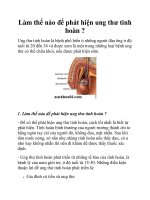Làm thế nào để hạ gục kỳ thi CCIE Lab docx
Bạn đang xem bản rút gọn của tài liệu. Xem và tải ngay bản đầy đủ của tài liệu tại đây (121.49 KB, 4 trang )
Làm thế nào để hạ gục kỳ thi CCIE Lab
Scott Morris là một trong số ít những người trên thế giới có 4 chứng chỉ CCIEs
(R&S,Security, ISP Dial, Voice).
Scott có viết một bài viết rất đặc biệt trên tạp chí Packet số quý 1 đầu năm 2003.
Tuy đã cũ nhưng những lời khuyên trong bài viết này vẫn giữ nguyên giá trị đối với
những ai đang chuẩn bị cho kỳ thi CCIE lab.
Conquering the CCIE
Lab
A Veteran’s Advice on Preparing for the Rigors
of the CCIE
By Scott Morris
The CCIE® Certification from Cisco is one of the most respected certifications in the
networking industry. At the time this article was written, there were an estimated
9600 CCIEs (only about 8700 active CCIEs) from countries across the globe.
Every day many more people are working diligently to achieve this certification and
take the test in some of the nine CCIE labs around the world. And everyone who
works toward this goal likely asks the same question: How do I conquer the CCIE
lab?
First and foremost, the answer is study, study, study. Second, nothing replaces
hands-on experience with Cisco equipment. Anyone can study networking theory and
recite how the Open Shortest Path First (OSPF) Protocol works, but not everyone can
put the theory into practice. Worse, if something goes wrong, even fewer people can
debug their way through a problem.
Currently, there are three CCIE program tracks: Routing and Switching,
Communications and Services, and Security, of which the most popular and common
track is Routing and Switching. The one-day, eight-hour exam tests a wide variety of
topics. Take a look at those topics.
Where Do I Start?
You should start preparing for the CCIE lab well before you schedule your lab exam
and continue up until you save your last-minute configurations. You do remember to
save your configurations, don't you?
The CCIE lab requires mastery of the Cisco IOS® Software that comes only from
extensive access to routers and switches, so owning a home lab gives you the best
access. With a home lab you can maximize your study time and work at your own
pace. Renting rack time, particularly for more expensive technologies such as ATM
and voice, is an economical method of studying.
What Do I Study?
The short answer is everything. Good study habits are essential. Repeat procedures
as often as possible, altering scenarios as you go.
When going through various books or the documentation CD, take copious notes.
After completing a book or technology section, transpose your notes into a computer
document. The seemingly repetitive task of editing and interpreting your handwritten
notes keeps details fresh in your mind.
After you have compiled configuration guides for almost all technologies, start
working on action scenarios. Whether you devise your own scenarios, mimic real-life
networks, or purchase lab scenarios, you can use your study notes. When you
transition from the book notes to the scenario configurations, use your notes and
further edit them. Keep editing this document as you delve into new books or areas
of Cisco.com.
Attend a CCIE lab prep course and purchase CCIE lab scenarios. While these cost
money, they can be invaluable to introduce other perspectives on the pertinent
technologies. When you attend a prep course, you typically get additional scenarios,
books, and notes. Best of all, you work with your peers and have access to an
instructor.
Take the lab prep course only after you are familiar with basic and advanced
technologies. A lab prep gives you a chance to hone your new skills. You will get the
most value out of the course if you use it to "fill in the blanks." Network Learning
offers a five-day, intensive bootcamp (www.ccbootcamp.com) that covers many
issues and lab scenarios that expose students to problem areas in the CCIE lab. The
lab prep course is a 12+ hour-a-day experience, including a full-day lab simulation.
When choosing a prep course, there are several important considerations: the
technologies available (ATM, voice, Cisco Catalyst® 3550, for example), the
instructor's experience level, and equipment availability. With the CCBootCamp Lab
Prep course, every student has their own pod of equipment for the week-long class,
plus remote Telnet access to the equipment for nine days following the class. All
pods have ATM, voice, and Cisco Catalyst 3550 switches. In the CCIE Security Lab
Prep course, Cisco PIX® firewalls are available on every pod as well.
After many hours of studying, transposing, editing, and configuring various
scenarios, you may be ready to attempt the CCIE lab. However, tackling the exam
also requires mental preparation. Some people perform better at tests than others,
and the psychological aspects of the exam are not to be taken lightly.
Tackling the Exam
The CCIE lab exam occupies a grueling eight hours, and depending on where you
take the exam, you may start as early as 7:30 a.m. You come in to the exam with
other candidates like yourself typically quiet, sullen, and trying to remember
everything that was in the document that they so carefully edited and added to over
the months.
To help you manage stress and use time efficiently, try keeping a running tally of
how many points you should have earned at various places within the test. Then if
you are running out of time, you can add up how many points you should have and
determine how best to earn the remaining points you need. Use this strategy when
you encounter problems on an isolated portion of the lab, such as the data-link
switching (DLSw) section. If you aren't good at DLSw and you can complete other
topics without difficulty, work on those topics. Determine where points are best
earned.
What About the Things I Don't Know?
Issues always come up that you may not have anticipated. When I took the lab for
the first time in 1999, I was convinced that I was going to pass. My study techniques
were great, my own lab scenarios were thorough, and I had practiced just about
everything I could imagine, so I thought I was unstoppable.
Needless to say, I ran across something I hadn't thought of. It messed up my entire
exam strategy and derailed my confidence, which caused me to fail. Upon returning
to work battered and irritated, one of my friends greeted me. "Welcome to the
human race," he said. Nobody can know everything there is to know.
If you do not pass the test the first time, try working with just the documentation
CD. Get to know the layout of the files, the structure of the technology pages, and
where each topic is within the configuration guides. Learn how to navigate without
using the search engine. Being a CCIE is not just about what you already know it's
also about your ability to work through the unknown, adapt, and overcome
unplanned obstacles.
A Final Word
You can conquer the CCIE lab with motivation, dedication, persistence, and focus.
With good study habits, thorough technology review, and an astute test-taking
approach, you can successfully survive the CCIE lab and look forward to the e-mail
that comes within a day or two and says, "Congratulations on passing the CCIE lab.
Your CCIE number is: ____."
As you are recovering from taking the CCIE lab and becoming reacquainted with your
family and friends, keep in mind that the learning is never over. The more you know,
the more you realize you don't know.
Best of luck to everyone!
Checklist for Success
1. When you get your lab guide, avoid the impulse to jump in and start configuring
the routers. You are not in a race with anyone but yourself. Read through the exam
more than once.
2. Because you have been studying and diligently updating your study notes
document with fresh ideas, you should be able to spot issues and potential pitfalls in
the lab exam. Use colored pens to diagram the network, connections, network
addresses, routing protocols, and anything else of note.
3. Make a checklist of the various exam sections and how many points they are
worth. Check off sections as you fully (and correctly) complete them. There is no
partial credit within a particular exam section, so if you miss the instruction to name
your switch "Bob" instead of "Switch," you have lost points. The small things can kill
you.
4. As you configure the lab, assume that, at some point, something won't work right,
or something new will come up that you don't remember. Whatever the issue, work
logically and try to "think" like a router does. Although Cisco IOS Software is very
powerful, routers themselves are not very bright. Often just "putting yourself in the
router's shoes" will give you the necessary perspective to fix a problem.
5. Do not spend unnecessary time trying to fix something. If you spend more than
20 to 30 minutes on a problem, it is time to move on. Sometimes changing focus lets
you see problems in a much clearer light. Stand up and stretch or get a drink; the
only prohibition is making calls to the Cisco Technical Assistance Center (TAC) from
the CCIE lab.
Scott Morris, CCIE
®
No. 4713, Certified Cisco Systems Instructor (CCSI), has been
involved in internetworking and integration for more than 15 years. He is currently a
triple CCIE in Routing & Switching, ISP/Dial, and Security. As an instructor with
Network Learning, Inc., Morris works with a variety of technologies including IP
telephony, security, and cable modems. He also teaches the CCIE Routing &
Switching Lab preparatory course for CCBootCamp and has authored labs for the
course. He can be reached at









